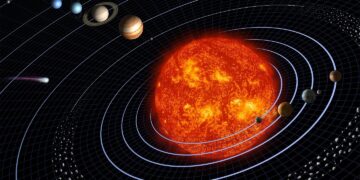What if the asteroid belt we know today had formed into a planet instead? This fascinating “what if” scenario has been explored by planetary scientists Emily Simpson and Howard Chen in groundbreaking research that maps how the solar system’s structure might have evolved differently. Their findings, published in Icarus, simulate the effects of a “super-Earth” between Mars and Jupiter, providing intriguing insights into planetary formation and habitability.
The Idea Behind the Study
Simpson and Chen sought to understand how the presence of a massive planet, rather than the asteroid belt, would influence the orbits, tilt, and seasonal dynamics of the inner planets. By simulating a range of potential planet masses—from small Earth-sized planets to giant super-Earths—they revealed the delicate balance required for maintaining the solar system’s habitability.
In her study, Simpson posed a fascinating question: What if a planet at least twice the size of Earth had formed where the asteroid belt currently resides? Collaborating with planetary scientist Howard Chen, she developed a 3D simulation to test this alternate history. The model explored how such a planet would affect the inner solar system’s habitability, tracking changes in the orbits, axial tilts, and eccentricities of planets like Earth, Venus, and Mars.
This hypothesis isn’t just theoretical curiosity. Understanding how the inner solar system would respond to the gravitational pull of a super-Earth can provide critical insights into the conditions that sustain life—on Earth and potentially on exoplanets orbiting distant stars.
Why a Super-Earth?
Simpson’s research used cutting-edge 3D simulations to model the solar system’s dynamics over 2 million years. Five different masses for the hypothetical planet were tested, ranging from 1% to 10 times Earth’s mass. Each scenario examined how the new planet’s gravitational influence would alter the orbits (eccentricity) and axial tilts (obliquity) of the inner planets.
For planets like Earth, obliquity influences seasonal intensity—higher tilts lead to harsher winters and summers, while eccentricity determines the length of seasons. By simulating these parameters, the researchers could evaluate whether life could endure under each scenario.
The Simulation: Five Planetary Scenarios
In simulations where the hypothetical planet’s mass was relatively low (up to twice Earth’s size), the inner solar system experienced minimal disruption. Mars displayed slight wobbling, but Earth remained comfortably within the habitable zone. Seasonal patterns changed slightly, with summers becoming marginally hotter and winters colder, but these shifts were far from catastrophic.
Howard Chen summarized this outcome succinctly: “If it’s one or two Earth masses, our inner solar system would still remain quite nice.” This suggests that life could still thrive in such a scenario, albeit with minor climatic adjustments.
Small Masses: Minimal Disruption
The story changes dramatically when the hypothetical planet’s mass increases to 10 times that of Earth. In these scenarios, the gravitational influence became overwhelming, destabilizing the inner planets. Earth’s obliquity and eccentricity soared, leading to severe seasonal temperature swings and chaotic orbital patterns. At this mass, Earth’s orbit shifted closer to Venus, pushing it out of the habitable zone and threatening life as we know it.
This finding highlights a critical threshold for super-Earth masses in determining planetary habitability. “If it’s too massive, that would probably spell doom for the planets within its orbit,” Simpson explained.
The Astrobiological Implications
Simpson’s research has profound implications for astrobiology. It highlights the importance of a system’s architecture in determining habitability. If a super-Earth were positioned in a similar location in another system, astrobiologists could assess its size and influence to predict whether life could exist on neighboring planets.
Future Directions: Mapping Other Scenarios
While Simpson and Chen’s research is hypothetical, it opens the door for further studies. Researchers can use similar models to simulate other variations in solar system formation or to test the impact of hypothetical planets in exoplanetary systems.
Conclusion: The Value of “What If” in Science
Exploring an alternate solar system offers more than speculative intrigue—it deepens our understanding of planetary science and habitability. The question of what might have been helps scientists appreciate the fragile conditions that make Earth unique, while also guiding the search for other habitable worlds in the vast expanse of the cosmos
Reference:



















